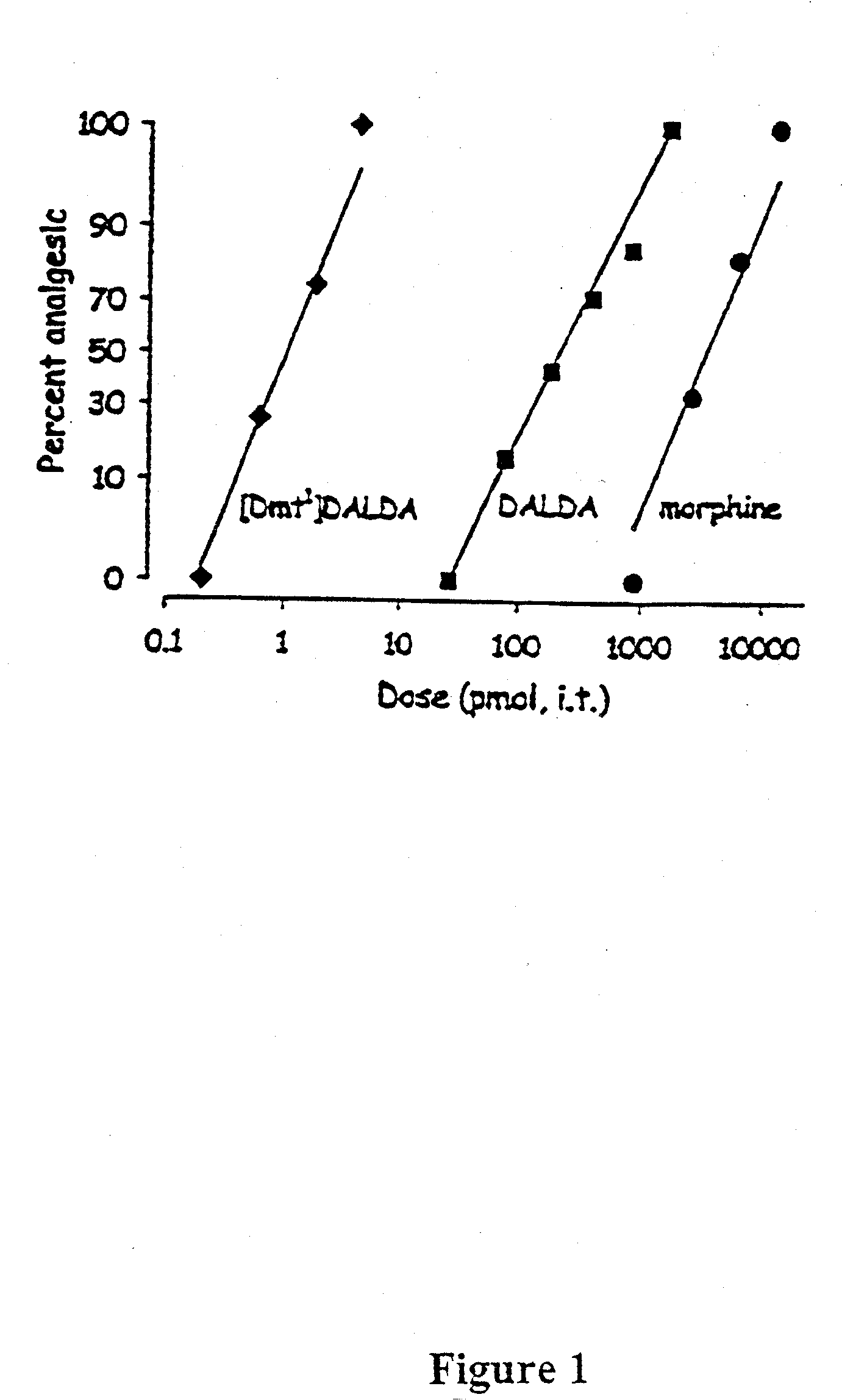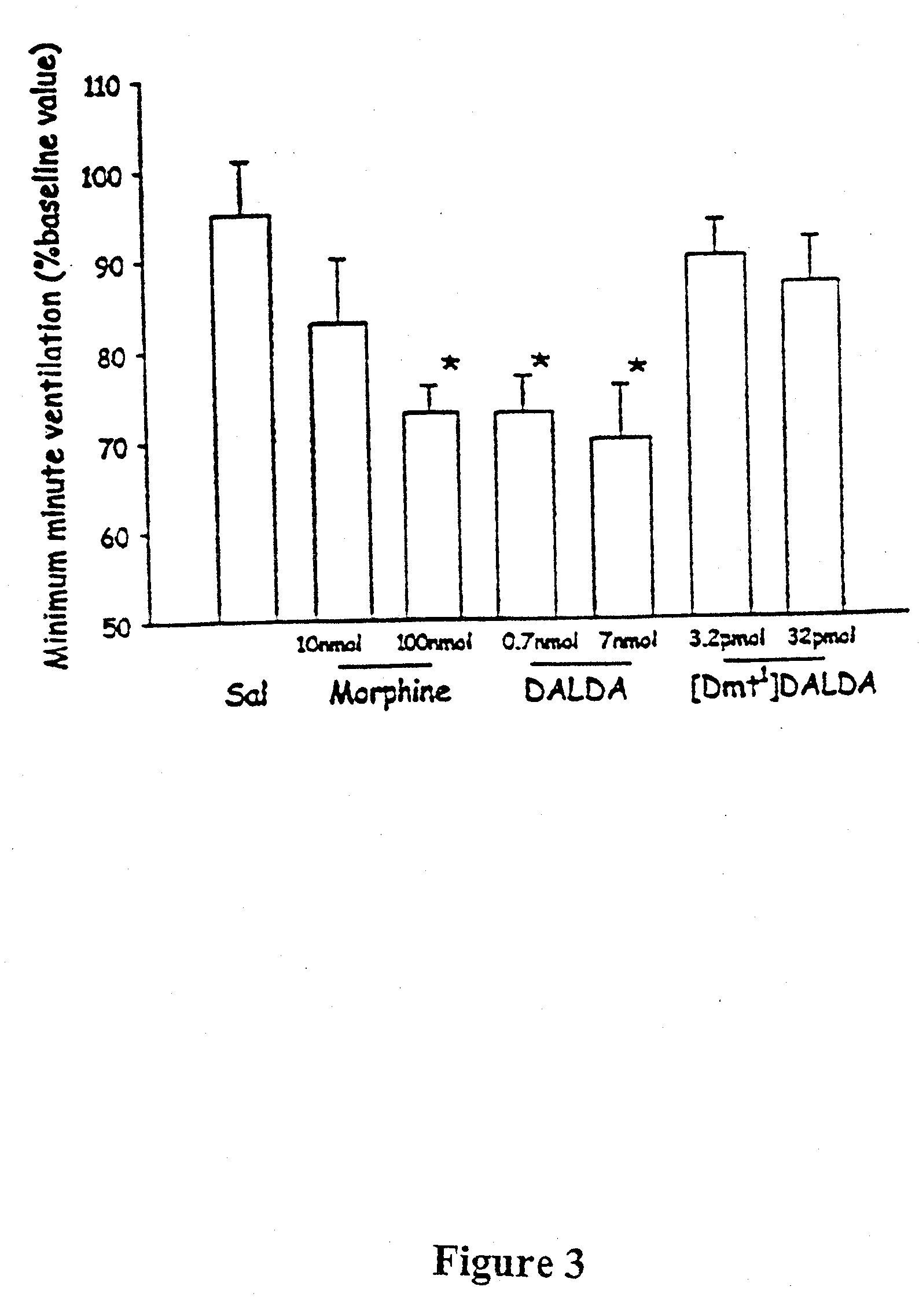Medicinal Uses of Mu-Opioid Receptor Agonists
a technology of mu-opioid receptor and agonist, which is applied in the direction of drug composition, peptide/protein ingredients, cardiovascular disorders, etc., can solve the problems of reducing fetal oxygen availability, opioid use has many dangerous side effects, and can adversely affect the fetus, so as to reduce the pain of pregnant women, reduce the rate and intensity of uterine contraction, and inhibit the uptake of norepinephrine
- Summary
- Abstract
- Description
- Claims
- Application Information
AI Technical Summary
Benefits of technology
Problems solved by technology
Method used
Image
Examples
example 1
Experimental Methods for Determining Analgesic Potency and Respiratory Effects of DALDA and [Dmt1]DALDA after Intrathecal Administration in Rats
Animals
[0070] Male Sprague-Dawley rats (300-350 g) were used.
Drugs and Drug Administration
[0071] [Dmt1]DALDA and DALDA are synthesized by methods known in the art. See, for example, Brown, et al, U.S. Pat. No. 5,602,100 and Schiller et al, J. Med. Chem, 32, 698-703 (1989). Naloxone hydrochloride was obtained from Sigma, St. Louis, Mo. Each drug was dissolved in saline. Intrathecal delivery was performed either by direct injection or via an intrathecal catheter depending on the study.
1) Direct Percutaneous Injection.
[0072] Under light halothane anesthesia a needle connected to a Hamilton syringe was inserted percutaneously between spinal processes of the third and fourth lumbar vertebrae into the intrathecal space. A quick flick of the tail was observed when the tip of the needle entered the intrathecal space and was used as an indi...
example 2
Analgesic Testing
[0074] To assess the antinociceptive effects of the opioids, the tail-flick test was used. Radiant heat was applied to the tail at 5-8 cm from the tip using a tail-flick apparatus (IITC, Woodland Hills, Calif.). The time from the onset of the heat to the withdrawal of the tail (tail-flick latency) was measured. The intensity of the radiant heat was adjusted so that baseline latencies would fall between 2.5 and 3.5 seconds. To avoid tissue damage the heat stimulus was discontinued after seven seconds. A baseline latency was obtained for each animal prior to the administration of any drug. Subsequent response latencies were determined at designated time points. Analgesic testing was performed by a blinded investigator.
Study 1. Analgesic Potencies of Intrathecal Morphine (“MOR”), DALDA and [Dmt1]DALDA
[0075] Cumulative dose-response studies were performed for each drug using the tail-flick test (Shimoyama et al., 1996), (Shimoyama et al., 1997). Each drug was teste...
example 3
Experimental Methods for Determining Analgesic Potency of Subcutaneous [Dmt1]DALDA in Mice
Antinociceptive Assay.
[0090] The antinociceptive assay was a modification of the radiant tail-flick test described by Tulunay and Takemori (1974). The data were made quantal by designating a positive antinociceptive response as one exhibiting an increased latency to tail-flick of at least 3 SD above the mean latency of animals not given the drug.
Intrathecal Injections.
[0091] Drugs were injected i.t. (Hylden and Wilcox, 1980) in a volume of 5 ul / mouse, and the latencies measured 30 min after the injections.
Tolerance Measurement.
[0092] Mice were made tolerant to morphine by s.c. implantation of one morphine pellet (containing 75 mg morphine free base) for 72 hr. The degree of tolerance was determined as the ratio of the AD50 value of agonist in morphine-pelletted mice to that of placebo-pelletted mice (Way et al., 1969). The implanted morphine pellet was left intact during the antinocic...
PUM
| Property | Measurement | Unit |
|---|---|---|
| Fraction | aaaaa | aaaaa |
| Time | aaaaa | aaaaa |
| Time | aaaaa | aaaaa |
Abstract
Description
Claims
Application Information
 Login to View More
Login to View More - R&D
- Intellectual Property
- Life Sciences
- Materials
- Tech Scout
- Unparalleled Data Quality
- Higher Quality Content
- 60% Fewer Hallucinations
Browse by: Latest US Patents, China's latest patents, Technical Efficacy Thesaurus, Application Domain, Technology Topic, Popular Technical Reports.
© 2025 PatSnap. All rights reserved.Legal|Privacy policy|Modern Slavery Act Transparency Statement|Sitemap|About US| Contact US: help@patsnap.com



